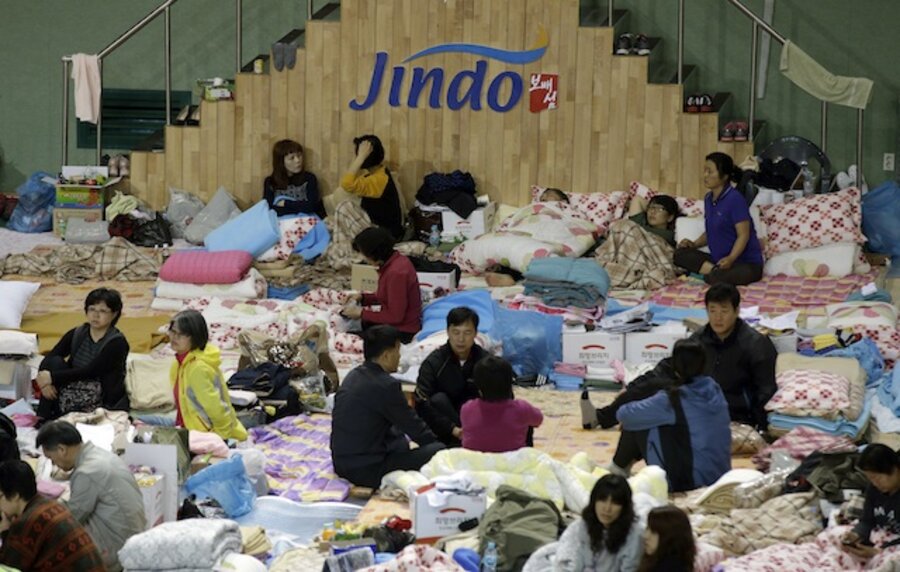Volunteers find scenes of hope, despair at S. Korea ferry site
| Jindo, South Korea
Hundreds of bereaved parents, relatives, and friends mingle with volunteers here in a display of agony and heartbreak, shame and disbelief, over the sinking of a ferry on a holiday cruise packed with high school students on a school excursion.
An atmosphere of stoicism and quiet calm pervades the floor of the spacious gymnasium in this pleasant seaside community as fathers and mothers, brothers and sisters, talk in low strained murmurs, lying on mats, wrapped in blankets, a week after the ferry, the Sewol, sank 12 miles south amid rocky islets visible to the horizon.
The ship was on a routine overnight voyage from the west coast port of Incheon to the resort island of Jeju when it took a sharp turn and capsized, taking down all but 174 of the 476 passengers and crew on board.
As investigators look for why and how the ship went down, volunteers have come from across Korea to hand out food and drink, fresh clothing, and toiletries. One volunteer tries to explain why the tragedy has resonated so deeply, from empathy for those suffering to outrage over the national humiliation of the disaster.
“When this happened, I realized I was neglecting my country,” says Youn Ji-na, a young woman who came from Seoul, 200 miles to the north. “This tragedy is the result of people not thinking about the country, about other people.”
In the gymnasium, sudden cries from a relative, the inconsolable weeping of a mother, frantic dashes to the tent where an official posts the latest count of recovered bodies interrupt the mood of quiet acceptance.
Through all such conversations runs the question of how such a tragedy could occur in a high-tech society where super-fast trains run all over the country, huge factories turn out the latest in modern gadgetry – electronics, motor vehicles, and industrial products sold worldwide – and "pali, pali" for quickly, quickly, is a common expression.
The authorities have arrested nine of the crew members, including the captain, three mates, three navigators, and the chief engineer, for abandoning the ship, but many believe the tragedy goes far deeper into the character of a nation periodically afflicted by disasters costing hundreds of lives.
Memories turn to the shoot down by a Soviet fighter jet of Korean Flight 007 as it veered off course over the Kamchatka peninsula in 1983, of the subway arson that killed nearly 200 people in the city of Daegu in 2003, of the collapse of a department store in Seoul in 1995 that killed 500.
Like many others, however, Ms. Youn tries not to view the tragedy quite so coldly, so analytically. “It’s not about national pride,” she says, struggling to convey how she feels. “Humanity and children come first. Every single one of us in Korea are deeply sorry, and we are totally responsible for this disaster. We put the kids in this situation. Every Korean is aching so much.”
A gulf exists, however, between the bereaved and those who wait with deceptive calm for news that will only deepen their sadness. Parents complain quietly that no one is listening – and then, gathering on the road between the gymnasium and the docks, engage in futile protest against the government that they hold responsible for the inadequate initial rescue and now for the prolonged recovery.
“At this point we have to rescue survivors,” says Ryu Duk-chu, whose young cousin is among those "still unaccounted for," and who is representing the relatives in talks with the coast guard and other officials. “
Mr. Ryu says authorities “are listening, but the outcome is not happening.” Until the divers have gone through the entire ship, up and down stairwells, through corridors, into cabins and storerooms, he says, “I have hope.”
Down by the docks, ambulances stand by, ready to take bodies to hospitals and mortuaries, while families of those whose bodies are already recovered prepare for funerals. Most of the funerals are in the Seoul suburb of Ansan, where 325 students on the ship were attending high school. Among the tents lining the dock, the letters “DNA” are painted in blue across the entrance to one of them. A coast guard team stands by waiting to swab the tongues of parents so they can match their DNA to bodies. More than 200 family members have volunteered DNA samples there and in a small room inside the gymnasium, also marked with a blue DNA sign.
Some parents, though, flinch at submitting their DNA and turn away. Nobody can force them. “It is too sensitive, too delicate,” a young coast guard sailor explains. “They don’t want to believe they will never see their children again. They wait to see if anyone is alive.”





